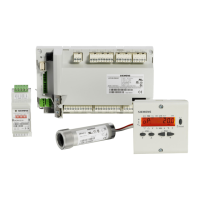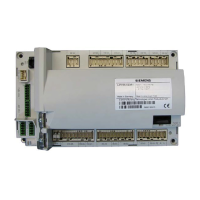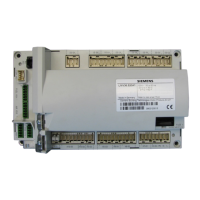16/213
Building Technologies Basic documentation LMV37.4... CC1P7546en
HVAC Products 1 Safety notes 01.12.2009
1.5 Electrical connection of flame detectors
It is important to achieve practically disturbance- and loss-free signal transmission:
• Never run the detector cables together with other cables
– Line capacitance reduces the magnitude of the flame signal
– Use a separate cable
• Observe the permissible detector cable lengths
• The mains-powered ionization probe is not protected against electric shock hazard.
It must be protected against accidental contact
• Earth the burner in compliance with the relevant regulations; earthing the boiler
alone does not suffice
• Locate the ignition electrode and the ionization probe such that the ignition spark
cannot arc over to the ionization probe (risk of electrical overloads)
1.6 Commissioning notes
• When commissioning the unit, check all safety functions
• There is no absolute protection against incorrect use of the RASTx connectors. For
this reason, prior to commissioning the plant, check the correct assignment of all
connectors
• Electromagnetic emissions must be checked on an application-specific basis
After the plant has been installed and commissioned, the person responsible for the
plant / heating engineer must document the parameterized values and settings (e.g.
curve characteristics)used for air-fuel ratio control.
These data can be printed out with the help of the ACS410 PC software, for example, or
must be written down.
This document must be kept in a safe place and checked by the expert.
Caution!
On the OEM level of the LMV37.4..., parameter settings other than those speci-
fied in the application standards can be made. For this reason, check whether
the parameter settings made are in compliance with the relevant application
standards (e.g. EN 298, EN 230, EN 676, EN 267, etc.), or whether the respective
plant demands special approval!
The selected setting values of fuel and combustion air must be assigned such that –
while giving consideration to the combustion chamber / fuel pressure, temperature and
combustion air pressure, as well as wear of actuators and controlling elements, etc. –
correct operation with sufficient amounts of excess air is ensured across the burner’s full
output range for an extensive period of time (until the next regular inspection is due; also
refer to section Monitoring the positions). This must be proven by the burner / boiler
manufacturer by measuring the characteristic combustion process values. If the stan-
dardization process is repeated, the air-fuel ratio control system must be rechecked.
Prior to commissioning the system, the following points must be checked:
• Parameterization of operating mode (e.g. «G mod», «Gp1 mod», «Lo mod», etc.)
must accord with the type of burner used (refer to chapter Selection of operating
mode)
• Correct assignment of the valves to the valve outputs of the LMV37.4...
• Correct setting of the time parameters, especially the safety and prepurge times
• Correct functioning of the flame detector in the event of loss of flame during opera-
tion (including the response time), with extraneous light, during the prepurge time
and, when there is no establishment of flame, at the end of the safety time
• Activation of the valve proving function and determination of the correct leakage
rate, if required by the application (refer to subsection Valve proving)
Air-fuel ratio
control system
Basic unit section

